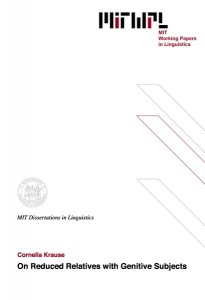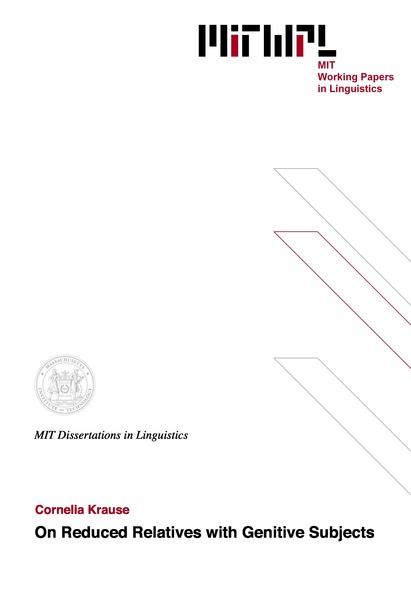On Reduced Relatives with Genitive Subjects
C. Krause, 2001
What is the place of relatives with genitive subjects in a typology of relative clauses? Are they full or reduced, headed or free relatives? Can they appear pre- and postnominally? Can they be head-internal relatives? Are they finite or non-finite? Can they be restrictives and appositives? These are the questions that this thesis will address.
Full relatives have nominative subjects. Thus, relatives with genitive subjects are not full relatives. Relatives with genitive subjects share, however, many properties with reduced relatives. Among others, both prohibit relative pronouns and complementizers. Both employ participles, i.e., verbs that lack tense but exhibit nominal properties. Both prohibit nominative subjects. Therefore, it will be argued that relative clauses with genitive subjects are reduced relatives.
There exists, however, one difference between relative clauses with genitive subjects and standard reduced relatives. Only the former permits non-subject relativization. It will be argued that reduced relatives are headed by a NP and that the difference in permitting genitive subjects is caused by a difference in the case licensing mechanisms within this NP. Only if N can license structural genitive case can a language have relative clauses with genitive subjects.
The verb in reduced relatives lacks tense. If the finite/non-finite distinction is based on the presence of tense, then reduced relatives are non-finite clauses. Furthermore, there are no non-finite free relatives. Thus, reduced relatives must be headed relatives. Finally, reduced relatives cannot be appositives. Appositives are full clauses. Thus, reduced relatives can only be restrictive relatives. In certain contexts, however, reduced relatives permit another reading. They can receive Free Adjunt interpretations. This is because Free Adjuncts too are smaller than CP. Thus they depend on the matrix clause for their temporal interpretation. This can result in a reading according to which the events in the matrix and the adjunct clause co-occur, i.e., in a when-reading and in an if-reading if the matrix clause contains a modal. The reading that is always available to reduced adjunct clauses is the because-reading, which as a default is the most salient way for the adjunct to establish a logical connection to the matrix clause.
Thesis Supervisors: Sabine Iatridou, David Pestesky, Ken Hale
Titles: Professor of Linguistics, Ferrari P. Ward Professor of Linguistics,
Professor Emeritus of Linguistics

